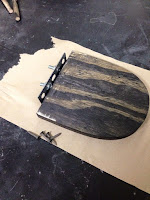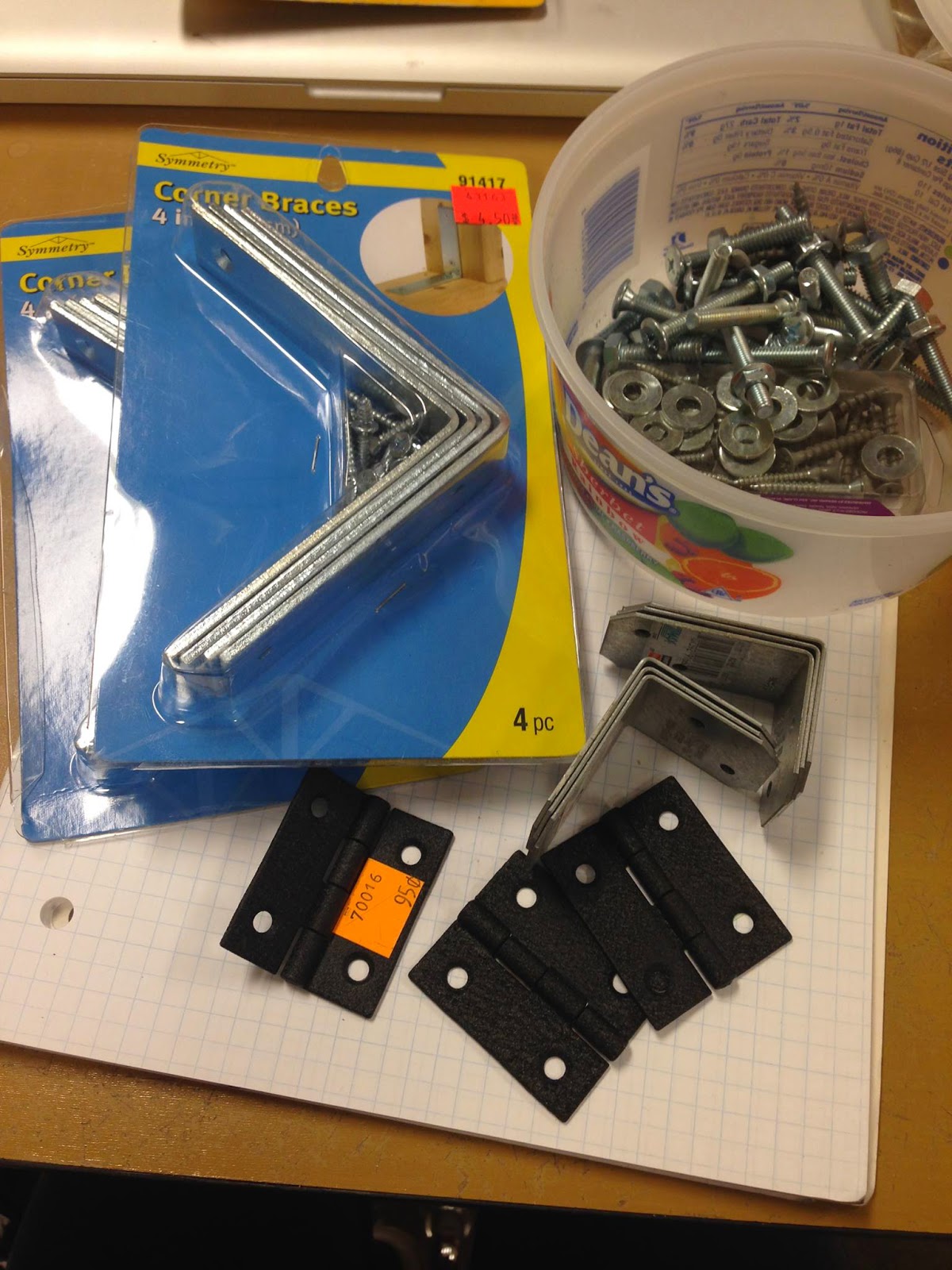A Look In My Book and Stuff.
Faceting for Amateurs:
[Below are four excerpts directly from Chapter 2 that I'm going to discuss in relation to the project and in general.]
_________________________________________________________________
"A faceting machine must enable the operator to place small flat surfaces, called facets, at various angles from 0 - 90 degrees. The machine should also facilitate the placement of these facets at any predetermined number of points around the circumference of the gem..."
http://gem-sphalerite.com/images_web/faceting/cutting_process/013_making_table_facet.jpg
Enabling the operator is important in reaching all necessary angles. I want to recreate the flexibility as accurately as possible while blending different designs for simplicity. Zero degrees is necessary to get the 'table' (above) on the top of gems and is achieved through a perpendicular relative angle above the lap. Ninety degrees is just as important because if the gem is going to be set into jewelry the edge should be rounded and roughed so it can be gripped. Additionally, reaching all in-between angles will be accomplished through adjusting on the X and Y with multiple angle definers for accuracy.
________________________________
"Any approach to precision [is] dependent upon the skill of the operator."
http://www.rockhounds.com/rockgem/articles/laplap3.jpg
This quote is talking about how it doesn't really matter what machine you use, even if its a hand faceter (above) where you have to find the facet sides yourself. In the end it's up to the operator alone to determine accuracy for the cuts. Taking this into account I want to make my machine as straightforward and easy to operate as possible so that the public who has little to no faceting skill or knowledge could give it a try, learn something new and leave with a creation of their own as proof instead of becoming frustrated and instantly turned off to the idea.
_________________________________
"Any machine that places accuracy as a secondary criteria [isn't] very attractive to amateurs. The amateur cuts gems primarily for enjoyment and thus insists upon a close approximation of perfection."
http://upload.wikimedia.org/wikipedia/en/thumb/e/ee/Squarestone.jpg/220px-Squarestone.jpg
Here again the book talks about accuracy and how important it is to be accurate when faceting. If a machine is too difficult to operate a beginner might become discouraged after multiple failed attempts. This discouragement is a direct result of them feeling like they're wasting time/effort/money, so if one were to make the entire process more simple and cheap less people would be opposed to attempting faceting. In order to resolve these concerns my practice faceting machine will remain easy to operate and the material that will be used (foam) will save money and time. A lot of hobbyists facet as a way to make additional income however, it's noted that enjoyment is the most common initial reason people get into faceting stones and that interest cant start if you've never been introduced.
_______________________________
"All [faceting machines] fall into one of two basic types, the mast and staff, and the platform. Each follows the same basic principal, but differs in constructional and operational details."
http://i749.photobucket.com/albums/xx138/miquel_bucket/P1050673.jpg
The most common type of faceting machine is the
Mast and Staff Arrangement (above) which is essentially an arm with joints that can hyperextend and hangs over the spinning lap. This structure is supported by X and Y rails placed alongside the lap so it can slide and swivel freely forward, back, up, and down to reach all the necessary angles. At the wrist of the arm theres a swivel point that allowing the operator the ability to check and pause work in-between cutting of the facets allowing the operator to gain more accuracy on the angles of the facets. There are many intricacies to the Mast and Staff Arrangement that allow the addition of angle cutting aids that can make faceting even easier. However, I do not plan to go for this design because of the complexities involved in creating the mechanical arm.
http://auctionimages.s3.amazonaws.com/59421/16138/5777283_35Z13TRFP.jpg
The less popular, older, and the type of
design that I chose for my practice faceting machine will be based off of a
Platform Arrangement, specifically an
O'Brien faceting machine (above). The only difference between these two arrangements is that rather than having an arm to reach angles, it's simplified even more to only a platform adjustable on the X and Y and a separate pen with calculated adjustable sided shapes on one end and foam on the other. Although the angles may be more abstract based off of the operators specifications, placement of the platform, and other process choices there are a lot of results that would otherwise be impossible to achieve with actual stone. This version of a faceting machine brings back a classic but simple design, making it more of a possible DIY project. This will also save time and effort in the production process for the machine hopefully encouraging additional interests.
_________________________________________________________________________________
[My Cliff Notes Version of...]
The Abridged List of Desirable Faceting Machine Features.
(Again also borrowing from Faceting For Amateurs (Chapter 2, pg. 23-24))
http://www.usfacetersguild.org/articles/glenn_klein/against_the_stop/against_the_stop.gif (above)
http://www.theimage.com/faceting/12ultrlap.jpg (below)

- The construction of a smooth operating faceting machine is of prime importance.
- There should be interchangeable index gears. ( 5, 6, & 8 are the most popular)
- There should be clear crisp divisions of measurements, so as to be easy to read/record data.
- The quill (pen) should be adjustable to 90 degrees.
- The elevating device for the mast should work easily and have measurement clearly defined.
- A cheater for minor adjustments is invaluable when polishing.
- The quill should also allow for the stone to be removed and examined.
- Angle-stops would be desirable to halt cutting at a certain point.
- The arbor must run true and be easily turned by a fractional horsepower motor. (1/4hp max)
- The machine should not be of great weight. Being heavy doesn't mean stable. (50 pounds max)
- A lap wheel of 6 inch diameter is quite satisfactory. (Enough space to cut an 100 carat gem)
- Power to the lap wheel should be delivered though a small cross section V-belt.
- If desired for portability it should be constructed/designed with this in mind.
- It should allow the operator to cut on both sides of the lap without changing its rotation.
- Some type of protection for the top arbor nut on the lap would be optimal.
Now I'm going to discuss how numbers 6, 7, 8, 14, and 15 may not apply exactly as they are explained above because of my decision to create an O'Brien style faceting machine rather than a mast and staff and because I'm creating mine for foam.
6. A cheater for minor adjustments will not be necessary since we will not be polishing the foam gems. Although it many be handy to realign the facet faces for the most part we wont be cutting the same one multiple times.
7. The platform style of an O'Brien faceting machine makes it so that the quill is readily removable and functions as its own piece. This removable quill (that I call the pen) will also have a fixable and removable piece within it that will be the only contact to the foam being cut.
8. Angle-stops (another cheater aspect of faceting machines) makes it so that when your cutting a side that the quill cannot go below the predetermined angle. In order to make the faceting process simpler I'm not sure if I'll include this. But if I do I may include it either on the pen or the platform.
14. I'm unsure if its a great idea to facet the foam on both sides of the lap or not. But since the pen is a completely separate piece it will be possible to reach both sides by manually adjusting and aiming and we can see if it is useful or even possible.
15. I intend to make the lap wheel out of wood and leave a space for the top of my screw to be flush. If this isn't possible I may just leave the convex top of the screw exposed which would only take a small portion of the lap up at the center.
http://metaphysicalstones.net/ART10.jpg
________________________________
For my next post I will include a list of materials and drawings.
Plans of designing, measuring and cutting out the box is my next step, then beginning assembly.
Thanks for reading! Peace.











.jpg)
.jpg)

















